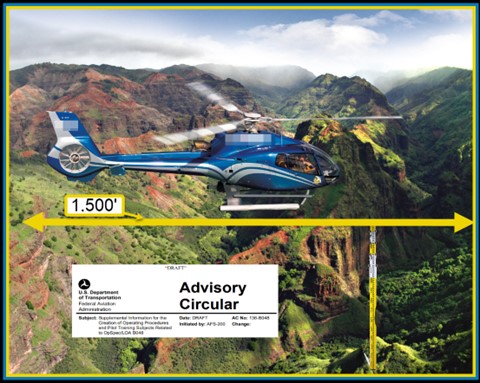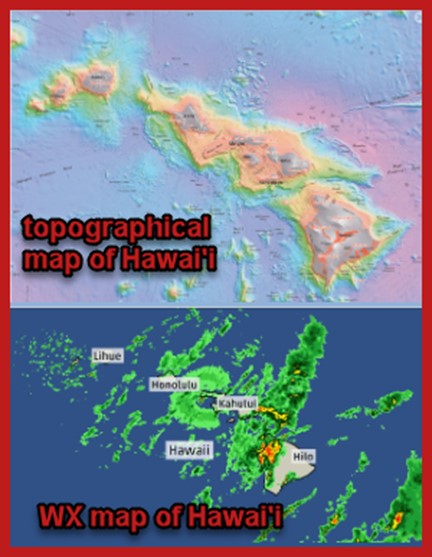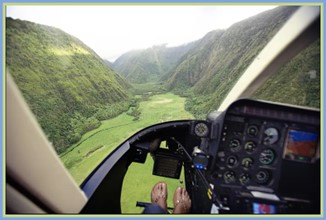FAA’s new policy on flightseeing in Hawaii – good balance or ground the planes

Aviation, airline flights to/from Hawaii, and flight seeing, constitute a significant aspect of the 50th State’s economy. This visibility is a double-edged phenomenon; the industry receives preferential political treatment, and its faults are easily chastised. Elected officials2 are equally likely to take credit for these flights’ economic impact and are quick to call a press conference after an accident.
Perhaps not as severe as the operational environment in the 49th state, Hawai’i’s irregular terrain, variable weather (quick changes) and attractive natural sights compound the determination of aviation risks on a daily basis. As noted in Mr. Shepardson’s article, the NTSB has repeatedly found fault with the state’s accident record.
What has been proposed has the potential to balance safety on the one hand with enjoyment of Hawai’i’s natural beauty via flightseeing. The text does not identify where implementation will lie on an SMS-like approach v. shutting down aviation’s tourism contribution to the 50th state’s economy
The FAA has issued a new PROCEDURE for Hawai’i operations (excerpts from the 23 page Advisory Circular:
“Authorization. In the interest of augmenting aviation safety among commercial air tour operators in the State of Hawaii, the FAA provides certificate holders (CHs) and operators with the option of obtaining an authorization … to conduct commercial air tour operations below 1,500 feet above the surface…
If a CH or operator wishes to obtain such an authorization, the Administrator will consider each individual application in its entirety and recommend the inclusion of additional aircraft equipment and inspections, safety risk analysis, FAA approval of pilot training, and FAA acceptance of operating procedures
…these authorizations are issued through the Flight Standards (FS) office responsible for safety oversight of the CH’s or operator’s operations; however, due to the UNIQUE ENVIRONMENT of the islands of Hawaii, each INDIVIDUAL APPLICATION PACKAGE WILL BE REVIEWED AND APPROVED BY THE HONOLULU FSDO prior to the issuance of OpSpec/LOA B048.
Operations Over Units of the NPS. In accordance with 49 U.S.C. § 40128, as codified in 14 CFR part 136 subpart B, commercial air tour overflights of national parks are subject to additional restrictions, as outlined in a park unit ATMP, an FAA-issued IOA, or FAA/National Park Service/Operator Air Tour Voluntary Agreements (VA).”
The compound, complex sentences with dependent clauses create a regulatory regime fraught with interpretation—between and among the CHs, application to the variety of meteorological conditions, forecasting of changes in precipitation/winds/visibility, among the specific areas to be overflown, the aircraft equipment (particularly each avionic/navigational suites) and the flight deck crews (experience in these conditions, familiarity with the equipment, team work, etc.) Decisions as to specific requests will define the REAL standards. The HI FAA offices are well aware of the high level of political scrutiny and will likely be rather restrictive in granting these special authorizations. Tracking the resolution of these requests may show a tendency to just say NO, that this procedure is a surreptitious program to shut down these flights.
The basic regimen of this Advisory Circular is to do a case-by-case analysis. Assessing risks using the specific indicia is a primary principle of SMS. The FSDO staff can come to balanced conclusions by careful review of the relevant data, quantifying the potential(s) for failure and creating a set of preventative parameters. The decisions need to be made in real time- the conditions change, and the opportunities are not static. If this challenging workload demand is met, this will constitute an EXEMPLARY REGULATORY SOLUTION to a nettlesome problem.
The regulatory institutional imperative is to establish bright lines, to create standards that are relatively easy to implement. ABSOLUTE RULES CONTRIBUTE TO EASIER REGULATION, BUT BLOCK THE JUDGEMENT NEEDED TO MAKE THE INFORMED RISK-BASED DECISIONS TYPICAL OF SMS. The implementation of AC No: 136-B048 will tell a tale of which approach will be used to assure SAFE FLIGHTS whilst providing tourists with EXTRAORDINARY VIEWS OF HAWAII’S NATURAL WONDERS.

US FAA Proposes Improvements to Hawaii Air Tourism Safety
By Reuters
Aug. 4, 2023, at 6:04 p.m.
By David Shepardson
WASHINGTON (Reuters) -The U.S. Federal Aviation Administration on Friday (8/4) proposed new procedures to improve the safety of Hawaii [STET: Hawai’i] tourist sightseeing flights by plane and helicopter after a series of fatal crashes including one in 2019 that killed seven people in bad weather.
The FAA proposed a new process for air tour operators to obtain authorization to safely descend below specific altitudes to avoid flying into bad weather. FAA Acting Associate Administrator for Aviation Safety David Boulter said the new process will help prevent situations in which pilots encounter poor visibility and become disoriented.
The regulatory agency also unveiled proposals to bolster safety management practices for Hawaii air tours including pilot training and aircraft equipment. The new safeguards are expected to be in place in early 2024.The FAA also is encouraging Hawaii air tour operators to adopt Safety Management Systems – programs to manage risks and assure the effectiveness of safety controls – while the agency finalizes rules to mandate them.
The National Transportation Safety Board last year cited the FAA decision not to implement some safety recommendations as contributing to the cause of a fatal Hawaii air tour helicopter crash that killed seven people in December 2019.
The seven-seat Airbus AS350 B2 helicopter crashed in deteriorating weather in a remote area of wooded terrain near Kekaha, Hawaii. The NTSB said the highly experienced, 69-year-old pilot flew into a mountainous region and was unable to exit the area of limited visibility.
From 2000 through 2019, there were 11 fatal helicopter tour crashes resulting in 45 deaths in Hawaii, according to government statistics.
NTSB Chair Jennifer Homendy said last year the safety board previously made 11 recommendations to the FAA to prevent accidents like the one in 2019 but they were not adopted.
FAA regulations require Hawaii air tour operators to fly at least at 1,500 feet (457 meters) above the surface unless they have authorization to fly lower. The proposed new process would help operators develop safety plans, the FAA said.
(Reporting by David Shepardson; editing by Will Dunham and Jonathan Oatis)
Copyright 2023 Thomson Reuters.
————————————————-
FAA Outlines Hawaii Air Tour Safety Improvements
Friday, August 4, 2023
WASHINGTON – The Federal Aviation Administration (FAA) is moving to improve Hawaii [STET: HAWAI’I] air tour safety.
The agency has outlined a consistent new process[1] where air tour operators can receive authorization to safely descend below specific altitudes to avoid flying into bad weather.
“This process will help prevent situations where pilots encounter poor visibility and become disoriented,” said David Boulter, the FAA’s Acting Associate Administrator for Aviation Safety.
FAA regulations require Hawai’i air tour operators to fly at least 1,500 feet above the surface unless they have authorization to fly lower. The new process provides detailed guidance to help operators develop safety plans to support their authorization requests.
The proposed new process includes recommendations for pilot training and qualifications and aircraft equipment. The FAA will thoroughly review each operator’s safety plan before issuing an authorization.
The public will have 30 days to comment on the new process, which will take effect in spring 2024. It would replace an outdated, 15-year-old manual.
The FAA also encourages Hawaii air tour operators to adopt Safety Management Systems while the agency works on a rule that would mandate these programs.
Additionally, all operators must follow the provisions of Air Tour Management Plans for Hawai’i National Parks.
[1] Supplemental Information for the Creation of Operating Procedures and Pilot Training Subjects Related to OpSpec/LOA B048
